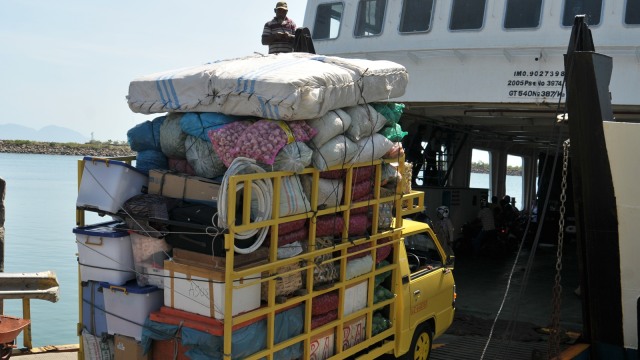Tentang KamiPedoman Media SiberKetentuan & Kebijakan PrivasiPanduan KomunitasPeringkat PenulisCara Menulis di kumparanInformasi Kerja SamaBantuanIklanKarir
2024 © PT Dynamo Media Network
Version 1.93.2
Konten dari Pengguna
International Arbitration as Settlement for Transnational Maritime Dispute
7 Juli 2021 11:44 WIB
·
waktu baca 6 menitDiperbarui 13 Agustus 2021 13:59 WIB
Tulisan dari Rima Gravianty Baskoro tidak mewakili pandangan dari redaksi kumparan

ADVERTISEMENT
Written by:
Rima Gravianty Baskoro, S.H.,ACIArb. (Listed Lawyer in Foreign Embassies and Associate of Chartered Institute of Arbitrators)
ADVERTISEMENT
I. MARITIME ARBITRATION
Since 1994, arbitration has been the most popular means of resolving maritime proceedings. Under Annex VII to the United Nation Convention of the Law Of the Sea (UNCLOS), the court consists of 5 arbitrators, each party to the dispute appoints one arbitrator and they jointly appoint three others. In case it is required, the President of International Tribunal of the Law Of the Sea (“ITLOS”) authorized to appoint the Chief of Panel of Arbitrators. The arbitral tribunal decides on its own procedures which provides a great deal of flexibility. Some examples of UNCLOS Annex VII Arbitrations include:
The Southern Bluefin Tuna Case;
Mox plant case (Ireland vs United Kingdom)
ADVERTISEMENT
Land Reclamation by Singapore in and around the Straits of Johor (Malaysia v. Singapore)
Arbitration between Barbados and the Republic of Trinidad and Tobago, relating to the delimitation of the exclusive economic zone and the continental shelf between them
Arbitration regarding the delimitation of the maritime boundary between Guyana and Suriname
Bay of Bengal Maritime Boundary Arbitration (Bangladesh v. India)
Chagos UNCLOS Arbitration (Maurice V. UK)
ARA Libertad Arbitration (Argentina v. Ghana)
West Philipine Arbitration (Philipine v. China)
Duzgit Integrity Arbitration (Malta v. Sao Tome and Principe)
Arctic Sunrise Arbitration (Holland v. Russia)
The Atlanto Scandinavian Herring Arbitration
Etc
ADVERTISEMENT
In addition to Arbitration in Institution based on ITLOS, in the maritime sector, arbitration dispute resolution can also be applied based on arbitration clauses. One of the elements in Maritime Law that is commonly encountered is related to shipping. Shipping drives international trade and the global economy. Shipping connects the needs and fulfillment of needs between countries, economic and business needs between countries. Seeing the wide aspect of shipping that involves parties between countries, there will be interactions with different legal systems, considering that cargo ships are always moving.
As a bridge to overcome confusion over the validity of the legal system, arbitration is one of the effective solutions for resolving maritime disputes. Thus, it is important for the parties involved in the maritime business to include an arbitration clause in their maritime business agreement. This is an example of an arbitration clause for a maritime case:
ADVERTISEMENT
“Any dispute arising under this bill of lading shall be referred to Arbitration in London. The un-amended centrocon arbitration clause will apply”
"Any and all disputes arising out of or in connection with this contract, including any question regarding its existence, validity or termination, shall be referred to and finally resolved by arbitration in Singapore in accordance with the Arbitration Rules of the Singapore Chamber of Maritime Arbitration ("SCMA Rules") for the time being in force at the commencement of the arbitration, which rules are deemed to be incorporated by reference in this clause".
“Any disputes arising out of or in connection with this contract, including any question regarding its existence, validity or termination, shall be referred to and finally resolved by arbitration at SCMA in accordance with the Singapore Bunker Claims Procedure (“SBC Terms”) for the time being in force at the commencement of the arbitration which terms are deemed to be incorporated by reference into this clause”.
ADVERTISEMENT
II. MARITIME DISPUTE
Maritime disputes arise from activities that generally involve: financing, building, selling and acquiring ships, deploying ships, transporting goods by sea, ship insurance, cargo and other maritime activities, including all other business contractual relationships arising from the use of ships. The following are the various maritime disputes that usually arise between the parties to the agreement:
Charter party and Bills of Lading
Concerning dispute settlement in the commercial and legal understanding of charterparty negotiation also resolution for bills of lading disputes.
New Building
Concerning disputes for offshore vessels, negotiation and interpretation of new building contracts and resolve for such disputes arise before, during and after contracts are agreed for the building oe new ships.
ADVERTISEMENT
Sale and Purchase of Ships
Regarding the resolution of sale and purchase disputes, because ships are bought and sold through different standard forms and many of which are further amended.
Commodities
Regarding the international sale of commodities and the resolution of commodity related disputes. This is because the commodities carriage by ship is becoming more complex, since the trade of commodities and the nature of the commodities shipping are changes from time to time.
Ship Management
This is regarding the technical, crewing and commercial care of ships.
III. ADVANTAGE ON DISPUTE SETTLEMENT BY INTERNATIONAL ARBITRATION FOR MARITIME DISPUTES
a. Arbitration Fee
The cost of the case in arbitration depends on the number of demands of the litigating parties, so it is measured with certainty. In addition, in the arbitration forum, the cost of the case is borne by both parties with the same percentage (50% each).
ADVERTISEMENT
b. Panel of Arbitrators
In the Conventional Court, the case will be examined and decided by a Panel of Judges consist of 3 (three) judges. The Panel of Judges will be appointed by the Chief of the District Court. The weakness is that the appointed panel of judges does not necessarily have in-depth knowledge of the case to be examined. This results in case decisions based on legal considerations that are less than optimal. Whereas in Arbitration, if agreed, each party is given the freedom to appoint 1 (one) arbitrator as a member of the arbitral tribunal. The Chairman of the arbitration panel will usually be appointed by the chair of the arbitration. With the freedom to choose an arbitrator, the parties might believe that the arbitrator appointed is based on ability and knowledge as well as qualified knowledge of the case to be examined. Thus it is hoped that legal considerations in the arbitration award will be maximized.
ADVERTISEMENT
c. Dispute Settlement Examination
The process of examining Disputes in the Arbitration forum will be more flexible and less rigid. The Arbitrator Council will also always direct the parties to find a middle point so that the dispute can be resolved by a peace agreement.
d. Confidentiality
Arbitration disputes are closed so that no other party is allowed to enter to see the dispute examination process. Thus, the confidentiality of the parties and the parties will be well maintained, without any particular framing from the media or the public.
e. Time Period of Dispute Examination
Dispute Examination in Arbitration tends to be faster than dispute examination in conventional courts. The average dispute examination from the first trial until the arbitration award is read is approximately 180 (one hundred and eighty) days.
ADVERTISEMENT

